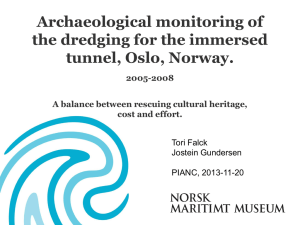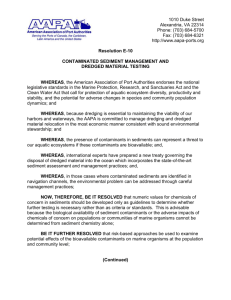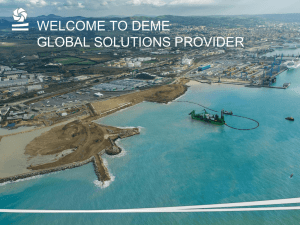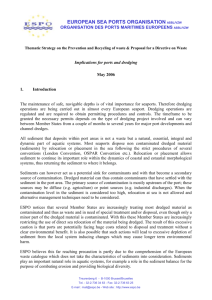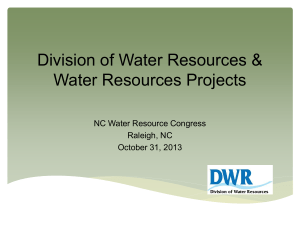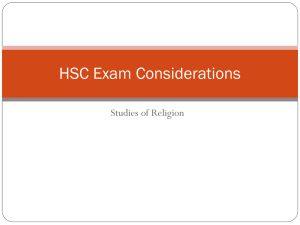European Dredging Association - Central Dredging Association
advertisement
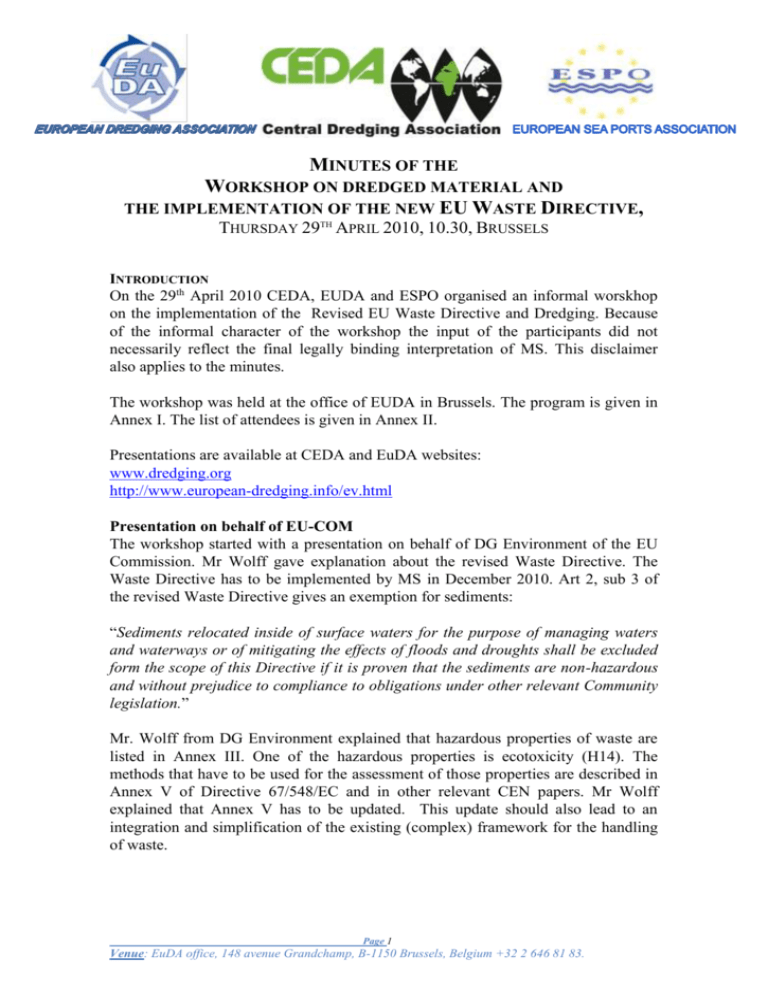
MINUTES OF THE WORKSHOP ON DREDGED MATERIAL AND THE IMPLEMENTATION OF THE NEW EU WASTE DIRECTIVE, THURSDAY 29TH APRIL 2010, 10.30, BRUSSELS INTRODUCTION On the 29th April 2010 CEDA, EUDA and ESPO organised an informal worskhop on the implementation of the Revised EU Waste Directive and Dredging. Because of the informal character of the workshop the input of the participants did not necessarily reflect the final legally binding interpretation of MS. This disclaimer also applies to the minutes. The workshop was held at the office of EUDA in Brussels. The program is given in Annex I. The list of attendees is given in Annex II. Presentations are available at CEDA and EuDA websites: www.dredging.org http://www.european-dredging.info/ev.html Presentation on behalf of EU-COM The workshop started with a presentation on behalf of DG Environment of the EU Commission. Mr Wolff gave explanation about the revised Waste Directive. The Waste Directive has to be implemented by MS in December 2010. Art 2, sub 3 of the revised Waste Directive gives an exemption for sediments: “Sediments relocated inside of surface waters for the purpose of managing waters and waterways or of mitigating the effects of floods and droughts shall be excluded form the scope of this Directive if it is proven that the sediments are non-hazardous and without prejudice to compliance to obligations under other relevant Community legislation.” Mr. Wolff from DG Environment explained that hazardous properties of waste are listed in Annex III. One of the hazardous properties is ecotoxicity (H14). The methods that have to be used for the assessment of those properties are described in Annex V of Directive 67/548/EC and in other relevant CEN papers. Mr Wolff explained that Annex V has to be updated. This update should also lead to an integration and simplification of the existing (complex) framework for the handling of waste. Page 1 Venue: EuDA office, 148 avenue Grandchamp, B-1150 Brussels, Belgium +32 2 646 81 83. Guidance on the assessment of ecotoxicity (H14) is not the most urgent issue for DG Environment. However a working group for the assessment of H14 already got started. The question was raised what to do if the guidance on the assessment on H14 is not available in December 2010. In that case it was suggested just to assume that the dredged material is hazardous (waste) and that the exemption is not valid. Presentations on behalf of MS. Germany Mr. Netzband from the Port of Hamburg and Mr. Köthe from the Federal Ministry of Transport explained the regulations for dredging in Germany. Because of the maintenance of waterways there is a need for dredging. The need for dredging In general the methods under the German Water regulations are used to decide about relocation/(re-)use of dredged material in the water system. If the Water regulations do not allow the use/relocation of dredged material the waste regulations are decisive for the handling of dredged material (on land). Starting point for this point of view is that sediments (dredged material) are an important resource for aquatic systems. Assessment of the hazardousness of dredged material therefore takes place under the Water regulations. Page 2 Venue: EuDA office, 148 avenue Grandchamp, B-1150 Brussels, Belgium +32 2 646 81 83. Both water regulations and the waste regulations are meant to protect the environment. It was emphasized that the methods used under the Water regulations differ from the methods in use under the Waste regulations. The methods under the Water regulations are considered to be more appropriate for the decision about relocation/use of dredged material in the aquatic environment than the (existing) methods under the waste regulations (terrestrial environment). An explanatory statement is part of the draft German transposition of the Waste Framework Directive: “Relocation is a change of location in or on the water. The term “Gewässer” includes waterways. Surface waters are all inland and coastal waters. The hazardousness of sediments is being evaluated solely in the basis of German and European water law. If hazardous sediments are to be relocated both the German Water Law and this law have to be applied.” United Kingdom Mr Vivian from Cefas explained the regulatory background of relocation of dredged material at sea in England and Wales and the role of Cefas. Cefas is a technical advisor to the decision makers (MMO). Cefas also incorporates results from R&D and disposal site monitoring into the technical advice provided on applications for licences for disposal of dredged material. Those licenses are in line with the Waste Framework Directive. The UK regulations (Environmental Permitting Regulations) were updated very recently. Because dredged material is regarded as a waste Page 3 Venue: EuDA office, 148 avenue Grandchamp, B-1150 Brussels, Belgium +32 2 646 81 83. material it is doubted if the article 2.3 exclusion offers the dredging industry anything. Mr Beckwith explained about dredging in freshwater in the UK. The methods in use were presented and explained. Bio-assays are not in use. Research made clear that severely contaminated sediments do not always form a risk for the (aquatic) environment. Mr Studds presented a case study in which 100.000 m3 of contaminated dredged material was (beneficial) used as backfill material for a sheet pile alongside a canal. By this approach disposal was avoided. In doing so the project saved: - (expensive) space in a landfill for hazardous waste energy and hindrance by transport of the dredged material (10.000 vehicle movements) the requirement of 100.000 m3 of primary building materials public costs (about € 1.000.000,- ) Page 4 Venue: EuDA office, 148 avenue Grandchamp, B-1150 Brussels, Belgium +32 2 646 81 83. The Netherlands Mr. de Boer explained about the regulations for dredging in the Netherlands. As in Germany and the UK there is a need for dredging because the waterways have to be maintained. Also in the Netherlands it is foreseen that dredging can be necessary if the objectives of the Water Framework Directive are not met. If sediments are causing water quality-problems, or if sediments would hamper the aquatic ecosystem, remedial dredging can become necessary. Further (capital) dredging is needed for flood control. Because of the implementation of the EU Water Framework Directive the legislation for dredged material has recently changed. From 2008 the relocation/use of dredged material (in freshwater and in the marine environment) is regulated under the Water Act by means of the Soil Quality Decree. By means of standards for chemical loads (contaminants) the Soil Quality Decree distinguishes different classes. The standards for the contaminants are based on ecotoxicological data. In general dredged material is regarded as non hazardous if it fulfils the standards of the Soil Quality Decree (and the EU-Water Framework Directive). EU Waste Directive Landfill Directive EURAL EU-WFD, OSPAR/LC ex-situ (chemical) in-situ investigation of quality and quantity (chemical and other methods) Research Operational level sediment dredging transport Water Act and decisions (2009), Natura 2000 Soil Quality Decree (2008), destination relocation direct use use of product Environmental management Act (198x?) treatment residue disposal If the standards of the Soil Quality Decree do not allow the relocation or use of dredged material the waste regulations apply. In the Netherlands the treatment and Page 5 Venue: EuDA office, 148 avenue Grandchamp, B-1150 Brussels, Belgium +32 2 646 81 83. disposal (discard) of dredged material is regulated by the Environmental Management Act. For dredged material several confined disposal facility’s were build in the Netherlands. Bio-assays are in use for monitoring but not for decision making about relocation or use. Mr. Schipper of DELTARES elaborated on the use of bio-assays. He explained that if the chemical analysis does not give enough certainty, further bio-analysis can help the decision making process. A proposal for the use of (good validated) bioassays for decision making about relocation or use of dredged material was presented. Belgium Mr Roose of the Maritime Division of the Flemish Government explained in short about the legal situation for dredging in Belgium. In Belgium there are different regulations to be followed. In the Western Scheldt the Dutch regulations apply. In the Sea Scheldt the regulations of Flanders apply and in the North Sea the Belgian regulations. Relocation and (re-)use of dredged material is possible under the Waste regulations. Presentation on behalf of SedNet A short presentation on the European Network for sediment issues, SedNet, was given by the chairman of SedNet, Mr Netzband. The mission of SedNet is to: “incorporate sediment issues and knowledge into European strategies to support the achievement of a good environmental status and to develop new tools for sediment management” Mr Netzband explained that sediment management has a broader scope than dredged material management. For sediment management it is important to also look upon sediments as an important resource and not just as a waste material. The SedNet network recommends to link sediment management (including dredged material management) to the Water Framework Directive. SedNet aims at providing guidance on how to include sediment management in River Basin Management Plans. River Basin Management will be more effective if sediment management will be included. Plenary Discussion The presentations raised different issues to be discussed in the afternoon. The issue about dredged material being waste or a resource was regarded as the most important issue. Representatives of the water management stated that dredged material should not be regarded as a waste material from the start. That is considered as the wrong entrance for decision making about the relocation and use of dredged material. However not Page 6 Venue: EuDA office, 148 avenue Grandchamp, B-1150 Brussels, Belgium +32 2 646 81 83. everybody agreed. It was pointed out that the definition of “discard” in the Waste Framework Directive includes the recovery of waste. It was pointed out that the presentations showed that daily practice in dredging does not differ a lot between MS. From that point of view the discussion if dredged material is a waste material or a resource is rather semantically. The terminology being used is not always clear to everybody. Clarification in MS legislation is very important. It was pointed out that the Waste Framework Directive has a pragmatic approach. The criteria for hazardousness have to be applied. However there still is no criterion for ecotoxicity (H14). There are worries that the use of bio-assays will make it necessary to change current practice and will lead to (substantial) higher costs for dredging. Some participants wondered why sediments were not excluded under art 2 sub 1. The text of art 2 sub 3 is not regarded as a real exemption of the Waste Framework Directive because assessment of hazardousness should take place in accordance with the waste regulations. If that is regarded as a problem, it was suggested not to make use of this exemption asa test on the criteria for hazardousness is not then necessary. Also in permitting it is not always necessary to test for hazardousness, not every risk is a hazard. However if the exemption is not used dredged material handling is fully under the Waste Framework Directive. Further it was briefly discussed that different environments (fresh water, marine environment, terrestrial environment) ask for different methods and that a risk based holistic approach should be followed. Everybody agreed on that. Mr Wolff invited CEDA to send a representative to the working group that is working on a criterion for H14. Conclusions Based upon the discussion and on a short questionnaire that the organising committee did circulate amongst the participants it was concluded that with regard to dredged material there is a difference of interpretation between the EU member states, of the link between the Water Framework Directive and the Waste Framework Directive. Both the Water Framework Directive and the Waste Framework Directive can be regarded as starting point for dredged material management. CEDA is very happy with the invitation to join the working group on H14 and will send a representative. It was concluded that a risk based holistic approach should be followed in the assessment of hazardousness of waste. Page 7 Venue: EuDA office, 148 avenue Grandchamp, B-1150 Brussels, Belgium +32 2 646 81 83. Further all participants recognised the need for knowledge exchange on the subject of dredged material and legislation and would appreciate if their involvement could be continued. The organising Committee for the workshop will keep everybody involved and if will organise a follow up workshop if necessary. Page 8 Venue: EuDA office, 148 avenue Grandchamp, B-1150 Brussels, Belgium +32 2 646 81 83. ORGANISING BODIES Central Dredging Association, www.dredging.org: The Central Dredging Association (CEDA) is an internationally recognised independent professional association operating in Africa, Europe and the Middle-East. It is an easy-to-access leading platform for the exchange of knowledge and an authoritative reference point for impartial technical information. Strongly recommending working with nature, CEDA actively strives to contribute towards sustainable development. CEDA members are corporations, professionals and stakeholders involved in a diversity of activities related to dredging and marine construction. CEDA is part of the World Organisation of Dredging Associations (WODA) and is responsible for Africa, Europe and the Middle East. European Dredging Association, www.european-dredging.info: Founded in 1993, EuDA is a non-profit industry organisation for European dredging companies and related organisations, representing approximately 25,000 European employees “on land and on board of the vessels” in direct employment and more than 48,300 in indirect employment (supply and service companies) with approximately 750 seaworthy European flagged vessels. Dredging activities are not well known by the larger public, but as a matter of fact European dredging companies are world market leaders with about 80% of the worldwide open dredging market and a turnover of €6.8bn in 2008. Although 70% of operations take place outside Europe, 90% of the returns flow back to Europe. EuDA represents the interests of the European dredging industry, primarily at the European institutions. The Association will pursue its goals by endorsing policies to create fair and equitable conditions for competition; commits to respecting applicable National, European and International rules and regulations; commits to operating its fleet safely, effectively and responsibly. EuDA serves its members in all kind of requests related to dredging issues which are coordinated by the Secretariat and executed by its specialised working groups, composed of experts from the member companies. Presently EuDA is strongly focusing Social and Environmental issues. European Seaports Association, www.espo.be: ESPO represents the seaports of the Member States of the European Union and has observer members from several other European countries. The European Union simply cannot function without its seaports. Almost all of the Community’s external trade and almost half of its internal trade enters or leaves through the more than 1200 seaports existing in the 22 maritime Member States of the EU. Without seaports, the European Union would not exist as an economic world power. Without seaports, there would be no internal market. ESPO ensures that seaports have a clear voice in the European Union. ESPO’s mission is to influence public policy in the EU in order to achieve a safe, efficient and environmentally sustainable European port sector, operating as a key element of a transport industry where free and undistorted market conditions prevail, as far as practicable. Page 9 Venue: EuDA office, 148 avenue Grandchamp, B-1150 Brussels, Belgium +32 2 646 81 83.


